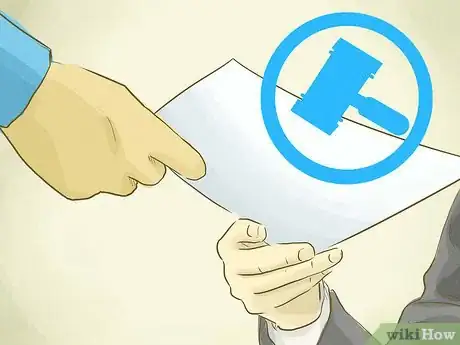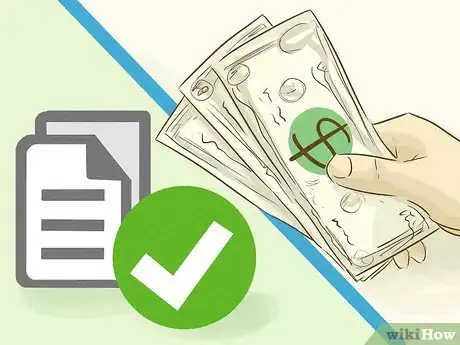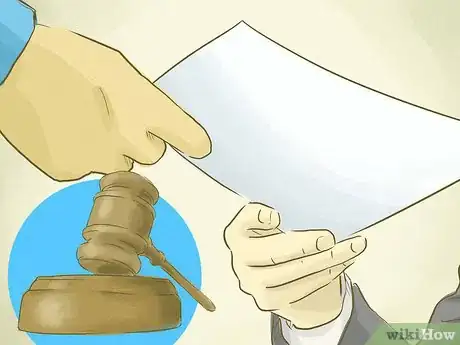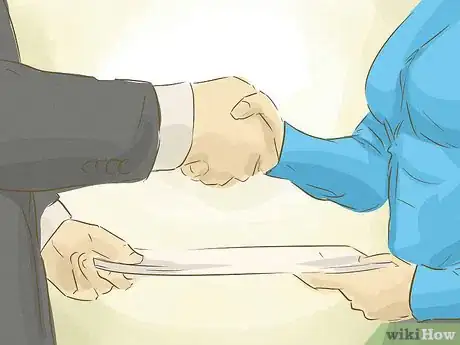This article was written by Jennifer Mueller, JD. Jennifer Mueller is an in-house legal expert at wikiHow. Jennifer reviews, fact-checks, and evaluates wikiHow's legal content to ensure thoroughness and accuracy. She received her JD from Indiana University Maurer School of Law in 2006.
There are 14 references cited in this article, which can be found at the bottom of the page.
This article has been viewed 26,257 times.
The United States court system is made up of a multitude of different types of courts, each with their own procedures for scheduling a hearing of your claim before one of their judges. And not only does this procedure potentially differ from state to state, it may even differ between courts in a single state. While each courthouse may have its own way of doing things, you can get a general understanding of how to schedule a court hearing in each type of court.
Steps
Scheduling a Hearing in Small Claims Court
-
1File your claim with the small claims clerk. When you file a claim, the clerk may put a date on your claim. This date typically is the deadline for the other side to respond.
- In some jurisdictions you don't have to show up at court on that date, but in others you do. The clerk will let you know if you are expected to be there.[1]
- For example, in Connecticut small claims court the clerk gives the defendant a deadline to respond. No one has to show up in court on that date.[2] However, in Indiana the clerk assigns a first date when you file your claim, and if the defendant intends to dispute your claim she must show up on that date. If she does not, you win by default.[3]
-
2Wait for an answer. The other side has a period of time to respond to your lawsuit. If there is no response, you can begin the process of requesting a default judgment.[4]Advertisement
-
3Contact the clerk to schedule a hearing. Once the other side responds, contact the clerk to get a hearing date.
- In some jurisdictions, the small claims clerk will put your case on the small claims docket automatically and mail both you and the person you sued notice of the date, time, and location of your trial. If the date does not work for you, you will have to file a continuance asking the court to postpone the trial.[5]
- If your jurisdiction requires you to show up to an initial hearing, the judge will set the matter for trial at that time if the defendant shows up and disputes your claim.[6]
-
4Send notice to the other side. If you select a date, you must send notice to the other side. If the clerk selects the date for you, the clerk generally will send notice to both parties.[7]
Scheduling a Hearing in Civil Court
-
1Look at the court's calendar. You may have to go to the courthouse to view the calendar, or it may be available online.
- If you want a hearing for a motion, be aware that many courts only hear civil motions on specific days of the week. You'll have to pick a "motion day" that works for you. Arrive at 9 a.m. on that day and be prepared to stay all day.[8]
- Courts typically close their motion day dockets a week or two before.[9]
-
2Contact the clerk to schedule a hearing. Once you've chosen the date you want, call the clerk and have your motion scheduled on that date.
-
3Include the date on your notice. You must draft a notice of hearing along with your motion that includes the date you've scheduled the hearing.
- In some courts, simply filling in the date on the notice of hearing is not enough to actually schedule it – you must have the hearing scheduled through the judge's chambers.[10]
- In some jurisdictions, you must file a separate form requesting the court set a trial or hearing in your case. A conference may be held with the judge and all parties to set the hearing.[11]
-
4File your motion. You must file your motion with the clerk of the court that will be hearing the motion.
-
5Send notice to the other parties in the case. After you've filed your motion, you must serve the other parties with copies of your motion and notice of hearing so they know what you're asking the court and when the court will hear it.
- The certificate of service you include with your motion details the method for serving the other parties. Typically you would use the sheriff's department to serve personally, or mail the documents using certified mail with returned receipt requested.[14]
Scheduling a Hearing in Federal Court
-
1Identify how much notice is required. Different types of motions may require you to allow different amounts of time for the other side to prepare. Check the rules for your motion to see how much notice you must provide.[15]
-
2Check the court's calendar. Typically, you are able to view the court's calendar online from the court's website.[16]
-
3Include the date on your motion. Follow local rules to determine where on your motion the date and time of your hearing should be located.[19]
-
4File your motion. Once you've finished your motion and all other necessary paperwork, file it with the clerk of the court that will hear your motion.
- In some courts, your motion also must include a noting date, which is the date the ruling on the motion will be ready.[20] Check with your clerk as this is a matter of local rules.
-
5Send notice to the other parties in the case. After you've filed your motion and scheduled your hearing, you must serve the other parties so they have notice of what the court is hearing and when.[21]
- The other parties may be served in person, using the sheriff's department or a private process serving company, or using certified mail.
Scheduling a Hearing for a Traffic Citation
-
1Call the phone number listed on your citation. Your citation may include either a phone number or a website where you can go to plead guilty or not guilty to the violation and schedule a hearing.
-
2Attend your arraignment. In some jurisdictions you may be required to appear in person if you are pleading not guilty.[24]
- If your attendance in court is mandatory, it should state this on your ticket. In some jurisdictions, you'll receive a notice a week before the court date that will specify whether your attendance in court is mandatory.[25]
-
3Request a hearing. When you are called, plead not guilty and request a formal hearing.
- The judge, a clerk, or other court staff will schedule your trial and subpoena the officer who wrote your ticket.[26]
References
- ↑ https://www.jud.ct.gov/Publications/CV045.pdf
- ↑ https://www.jud.ct.gov/Publications/CV045.pdf
- ↑ http://www.in.gov/judiciary/files/small-claims-manual.pdf
- ↑ https://www.jud.ct.gov/Publications/CV045.pdf
- ↑ https://www.jud.ct.gov/Publications/CV045.pdf
- ↑ http://www.in.gov/judiciary/files/small-claims-manual.pdf
- ↑ https://www.jud.ct.gov/Publications/CV045.pdf
- ↑ http://www.cityofchesapeake.net/government/City-Departments/courts-judicial-offices/Circuit-Court/civil-motions.htm
- ↑ http://www.cityofchesapeake.net/government/City-Departments/courts-judicial-offices/Circuit-Court/civil-motions.htm
- ↑ http://www.cityofchesapeake.net/government/City-Departments/courts-judicial-offices/Circuit-Court/civil-motions.htm
- ↑ https://www.courts.state.co.us/Forms/PDF/jdf1122.pdf
- ↑ http://www.scscourt.org/documents/fee_schedules/FeeSchedule.pdf
- ↑ http://www.scscourt.org/forms_and_filing/faqs/feewaivers.shtml
- ↑ https://www.courts.state.co.us/Forms/PDF/jdf1122.pdf
- ↑ http://www.cacb.uscourts.gov/faq/hearing-date-how-do-i-obtain-one-my-motion-and-provide-notice-hearing
- ↑ http://www.cacb.uscourts.gov/faq/hearing-date-how-do-i-obtain-one-my-motion-and-provide-notice-hearing
- ↑ http://www.cacb.uscourts.gov/judges/self-calendaring
- ↑ http://www.cacb.uscourts.gov/sites/cacb/files/documents/judges/self-calendaring/AA_SelfCalendaring.pdf
- ↑ http://www.cacb.uscourts.gov/faq/hearing-date-how-do-i-obtain-one-my-motion-and-provide-notice-hearing
- ↑ http://www.wawd.uscourts.gov/sites/wawd/files/ProSeManual4_8_2013wforms.pdf
- ↑ http://www.wawd.uscourts.gov/sites/wawd/files/ProSeManual4_8_2013wforms.pdf
- ↑ http://www.sanmateocourt.org/court_divisions/traffic/hearing_schedules.php
- ↑ http://www.miami-dadeclerk.com/traffic_civil_infraction.asp
- ↑ http://www.nola.gov/traffic-court/
- ↑ http://www.sanmateocourt.org/court_divisions/traffic/options.php
- ↑ http://www.sanmateocourt.org/court_divisions/traffic/options.php












































































